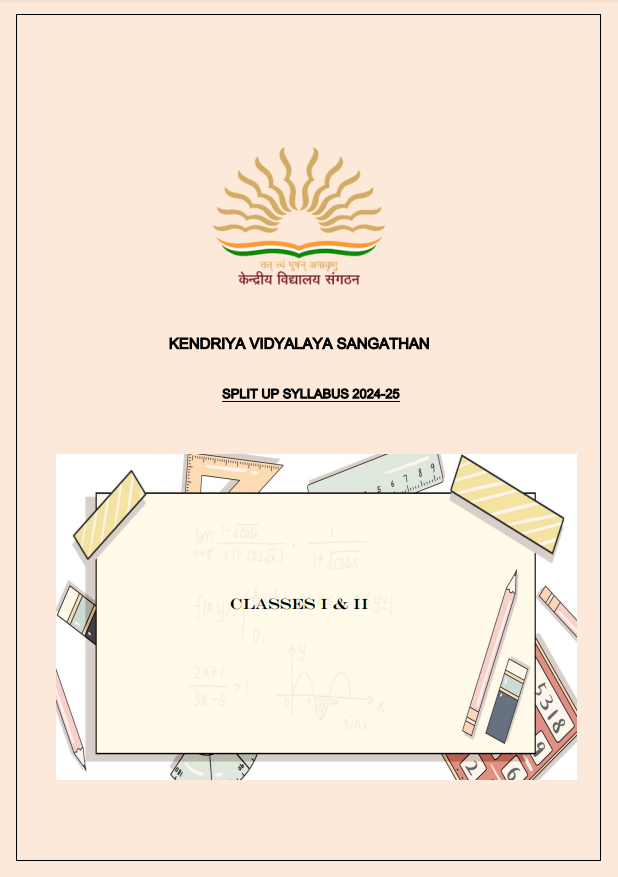
KVS Split-Up Syllabus for Classes 1 and 2: A Complete Guide
Introduction to the KVS Split-Up Syllabus
The Kendriya Vidyalaya Sangathan (KVS) split-up syllabus is a structured approach to academic planning that divides the syllabus into manageable portions for each month. For classes 1 and 2, this methodology ensures a balanced and effective learning environment, fostering foundational skills in young learners. The split-up syllabus offers clarity and simplicity, making it easier for teachers to deliver lessons and for students to grasp concepts at a steady pace.
Key Features of the KVS Split-Up Syllabus for Classes 1 and 2
1. Monthly Distribution of Topics
The syllabus for classes 1 and 2 is broken down into specific topics to be covered each month. This approach ensures systematic progress and prevents the accumulation of pending lessons.
2. Focus on Foundational Learning
The curriculum emphasizes basic skills such as reading, writing, counting, and comprehension, essential for the cognitive and social development of children.
3. Inclusion of All Key Subjects
For classes 1 and 2, the syllabus covers:
- English: Basic language skills like alphabets, simple words, and sentence formation.
- Mathematics: Numbers, addition, subtraction, and understanding basic shapes.
- Environmental Science (EVS): Basic concepts of surroundings, nature, and hygiene.
- Regional Language: Enhancing linguistic diversity and regional identity.
Detailed Subject-Wise Split-Up for Classes 1 and 2
English
- April-May: Introduction to alphabets and simple words.
- June-July: Building vocabulary and practicing short sentences.
- August-September: Introduction to rhymes and simple stories.
- October-November: Understanding basic grammar concepts like nouns and verbs.
- December-January: Revision and advanced sentence formation.
- February-March: Comprehensive review and assessment preparation.
Mathematics
- April-May: Numbers up to 20 and basic counting exercises.
- June-July: Introduction to addition and subtraction.
- August-September: Simple word problems and understanding shapes.
- October-November: Introduction to time and basic measurements.
- December-January: Patterns and advanced number concepts up to 50.
- February-March: Consolidation of mathematical concepts.

Environmental Science (EVS)
- April-May: Understanding the immediate environment (home, school).
- June-July: Learning about plants and animals.
- August-September: Basic hygiene and personal care.
- October-November: Weather and seasons.
- December-January: Festivals and cultural awareness.
- February-March: Summary and practical applications.
Regional Language
- April-May: Introduction to letters and sounds.
- June-July: Simple words and phrases.
- August-September: Rhymes and short stories.
- October-November: Vocabulary building and sentence practice.
- December-January: Grammar basics and comprehension exercises.
- February-March: Revision and fluency activities.
Benefits of the Split-Up Syllabus for Classes 1 and 2
1. Stress-Free Learning
The monthly division reduces the pressure on young learners, allowing them to explore concepts at a comfortable pace.
2. Enhanced Teacher-Student Interaction
The structured format enables teachers to plan engaging activities, fostering a positive learning environment.
3. Steady Skill Development
With gradual progression, children develop critical skills such as problem-solving, communication, and creative thinking.
4. Parental Involvement
The clarity of the syllabus allows parents to monitor their child’s progress and provide additional support when needed.
Tips for Making the Most of the Split-Up Syllabus
For Students
- Practice regularly to stay on track with the monthly schedule.
- Actively participate in class discussions and activities.
- Revise topics covered each month to strengthen understanding.
For Parents
- Create a study routine aligned with the syllabus.
- Use visual aids and interactive tools to enhance learning.
- Communicate regularly with teachers to track progress.
For Teachers
- Plan lessons creatively to keep students engaged.
- Incorporate storytelling, games, and hands-on activities.
- Provide feedback to students and parents regularly.
Challenges with the Split-Up Syllabus
1. Adherence to the Timeline
Keeping up with the monthly plan can be challenging if unforeseen disruptions occur.
2. Individual Learning Paces
Every child learns differently, and some may require additional time or resources to understand specific topics.
Conclusion
The KVS split-up syllabus for classes 1 and 2 is a well-thought-out framework that balances academic rigor with the developmental needs of young learners. By focusing on foundational skills, it sets the stage for lifelong learning. Teachers, parents, and students can collaborate effectively to maximize the benefits of this structured approach, ensuring a holistic and enjoyable educational experience.
FAQs
1. What is the purpose of the KVS split-up syllabus for classes 1 and 2?
The purpose is to provide a systematic and stress-free learning environment that fosters foundational skill development.
2. How can parents support their child in following the syllabus?
Parents can align home study schedules with the syllabus and engage their child with interactive learning tools.
3. Are there any extracurricular activities included in the syllabus?
Yes, the syllabus encourages activities like storytelling, art, and games to enhance overall development.
4. Is the split-up syllabus mandatory for all KVS schools?
Yes, it is implemented across all KVS schools to maintain uniformity in education.
5. Where can I access the detailed split-up syllabus for classes 1 and 2?
The syllabus is available on the official KVS website or can also be obtained from the school.
